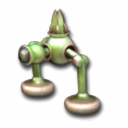
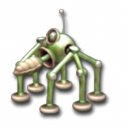
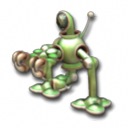
 Diet:
Diet: ??
Danger Level: 5 - 9
Social Ability: 7 - 17
Information: I was handed these files during my lunch break by our robotics department. This project, long since put on the shelves, has been revived due to the advance AI becoming sentient. In one sense or another, all four model types are now to be treated as life forms. Which is, apparently, where I come in.
The project itself was designed to provide a way to observe creatures without the loss of human life due to harsh environmental conditions or extremely dangerous predatory creatures, the latter being more common. Each model was equip with an AI (Artificial Intelligence) that could reprogram itself to suit any given situation. There were three different forms of this AI: passive, curious, and social. Models with a passive AI were programmed to strictly observe creatures from a safe distance. Models with a curious AI were given directives that would involve some level of interaction with a creature if it was determine to not pose a threat. Models with a social AI, essentially, were designed to have both programs installed as well as the addition to switch between the two if necessary.
The BioBot prototype ran using organic fuel generated through several different sources. The first was through solar panels located on the top of the model that would fold out and charge the battery. The second was internal where water would be both produced and destroyed through electrolysis in order to produce a back-up charge for dark or cloudy days. A design flaw in the structure of the robot made it extremely fragile. Should anything drop upon it or if it was to fall from any height, the model would shatter into a million pieces.
The second generation of this project brought two very different models. The first and most successful was the SGEI (Search and Gather Environmental Information) model. It was equipped with tools and grasping arms used to analyze matter and creatures it came across, both living and dead. A mouth-like attachment would occasionally lower in order to collect organic samples to be analyzed by the on-board computer. Information on these samples would then be broadcasted to a satellite that would relay the data to a server here at work. The sample would then be broken down and reused as fuel for the BioBot if possible. It was an ingenious design and praised by the scientists who were fortunate enough to see working models, but funding for this model ultimately killed any future production.
The second model to come out of the second generation of this project was the DHS (Drilling Herbivore Spider) model. It was an outside contract job in order to help generate revenue for the project, which at the time lost government funding due to being seen as a non-lucrative project. This model was designed to simultaneously observe alien wild life while searching for fossil fuels. The project was ultimately protested against by a few of the designers due to the hypocritical programming in how it was to go about finding organic fuel to continue functioning.
The third generation of this project saw a partnership with NanoTech
TM. No longer restricted to hard-joint legs, the team of designers at that time constructed the Mega BioBot 2800. It was intended to be a consolidation of all the previous models, both in their strengths and flaws. Two models were built with a third half-way through production before the model was considered too expensive to be practical.
I had to as my supervisor for permission to publish the following information, as it is extremely controversial. Forgive me if it offends you. My only request is that you do not blame me for this information.
These four models were sent to space in an unmanned shuttle carrying several tons of hazardous waste and obsolete government technology. In other words, the garbage of our planet that we can’t get rid of for fear of what they may end up doing to our environment. The shuttle was shot into deep space at random with the hope that it would collide with a star or some other celestial body and be destroyed.
We’ve recently received signals from each of these model of BioBots, which suggests the idea the rocket they were on didn’t exactly fulfill its original intent.
~Zeek Slider
 Diet: Omnivore
Diet: Omnivore Diet: Carnivore
Diet: Carnivore
 Diet: Carnivore
Diet: Carnivore
 Diet: Carnivore
Diet: Carnivore
 Diet: Carnivore
Diet: Carnivore
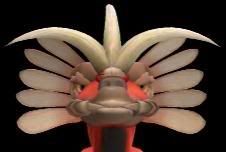 The wings also give this creature another benefit. When approached from the front, the wings give the appearance that the head is larger than it actually is. This is meant as a weapon of intimidation in order to drive away competing predators.
The wings also give this creature another benefit. When approached from the front, the wings give the appearance that the head is larger than it actually is. This is meant as a weapon of intimidation in order to drive away competing predators.
 Diet: Omnivore
Diet: Omnivore
 Diet: Carnivore
Diet: Carnivore
 Diet: Herbivore
Diet: Herbivore
 Diet: Omnivore
Diet: Omnivore
 Diet: Herbivore
Diet: Herbivore
 Females generally don’t use this water until after they have given birth. At which time, they use the collected water to wake up their young who have a habit of sleeping in during the early morning. Females also use this water to feed their young. They do this by standing under trees that are losing their leaves. Once caught in their dish of water, the leaves are ferried over for the offspring to consume with the water. It is hypothesized that this behavior is the mother helping introduce a solid food diet to her young.
Females generally don’t use this water until after they have given birth. At which time, they use the collected water to wake up their young who have a habit of sleeping in during the early morning. Females also use this water to feed their young. They do this by standing under trees that are losing their leaves. Once caught in their dish of water, the leaves are ferried over for the offspring to consume with the water. It is hypothesized that this behavior is the mother helping introduce a solid food diet to her young.
 Diet: Carnivore
Diet: Carnivore




 Diet: Herbivore
Diet: Herbivore
 Diet: Herbivore
Diet: Herbivore Diet: Omnivore
Diet: Omnivore
 Diet: Herbivore
Diet: Herbivore
 Diet: Carnivore
Diet: Carnivore
 Diet: Herbivore
Diet: Herbivore
 Diet: Omnivore
Diet: Omnivore
 Diet: Carnivore
Diet: Carnivore
 Diet: Omnivore
Diet: Omnivore
 Diet: Omnivore
Diet: Omnivore
 Diet: Carnivore
Diet: Carnivore
 Diet: Herbivore
Diet: Herbivore
 Diet: Herbivore
Diet: Herbivore


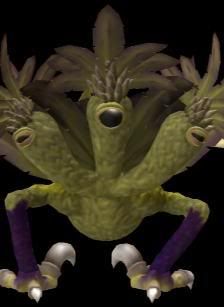 Another unique feature to this creature are the eyes hidden in its plumage. It uses these eyes to scan the area behind it while eating to ensure no other creature is trying to stalk it. During flight, these eyes are also used to locate prey targets its forward eyes may have missed.
Another unique feature to this creature are the eyes hidden in its plumage. It uses these eyes to scan the area behind it while eating to ensure no other creature is trying to stalk it. During flight, these eyes are also used to locate prey targets its forward eyes may have missed.
 Diet: Herbivore
Diet: Herbivore
 Diet: Carnivore
Diet: Carnivore
 Diet: Omnivore
Diet: Omnivore
 Diet: Omnivore
Diet: Omnivore
 Diet: Omnivore
Diet: Omnivore
 Diet: Omnivore
Diet: Omnivore
 Diet: Omnivore
Diet: Omnivore
 Diet: Carnivore
Diet: Carnivore
 Diet: Herbivore
Diet: Herbivore Diet: Herbivore
Diet: Herbivore
 Diet: Omnivore
Diet: Omnivore
 Diet: Omnivore
Diet: Omnivore
 Diet: Carnivore
Diet: Carnivore
 Diet: Omnivore
Diet: Omnivore
 Diet: Omnivore
Diet: Omnivore
 Diet: Omnivore
Diet: Omnivore